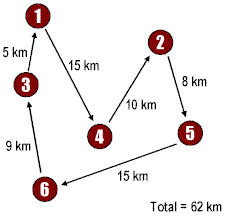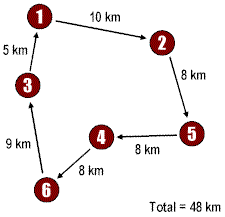Travelling salesman problem
Problem: Given a complete undirected graph G=(V, E) that has nonnegative integer cost c(u, v) associated with each edge (u, v) in E, the problem is to find a hamiltonian cycle (tour) of G with minimum cost.
A salespersons starts from the city 1 and has to visit six cities (1 through 6) and must come back to the starting city i.e., 1. The first route (left side) 1→ 4 → 2 → 5 → 6 → 3 → 1 with the total length of 62 km, is a relevant selection but is not the best solution. The second route (right side) 1 → 2→ 5 → 4 → 6 → 3 → 1 represents the must better solution as the total distance, 48 km, is less than for the first route.
Here is the java code along with output given. Enjoy,
import java.util.Scanner;
class TSP
{
static int c[][],n;
static int INF=100000;
static int cost;
static int path[];
static boolean intour[];
public static void main(String args[])
{
int i,j,k;
Scanner scr = new Scanner(System.in);
System.out.println("Enter no. of vertices");
n = scr.nextInt();
c = new int[n+1][n+1];
path = new int[n+1];
boolean s[] = new boolean[n+1];
intour = new boolean[n+1];
for(i=1;i<=n;i++)
for(j=1;j<=n;j++)
{
s[j] = true;
if(i==j)
{
c[i][j]=0;
continue;
}
System.out.println("Is there an edge from vertex "+i+" to vertex "+j+" ?");
System.out.println("Enter -1 if not else enter corresponding weight");
c[i][j] = scr.nextInt();
if(c[i][j]==-1)
c[i][j] = INF;
}
s[1]=false;
cost = travellingCost(1,s);
System.out.println("Solution :");
System.out.println("Path: ");
path[0] = 1;
j=0;
for(i = 0;i<n;i++)
{
System.out.print(path[j]+" ");
j = path[j];
}
System.out.print("1");
System.out.println();
System.out.println("Cost: "+cost);
}
public static boolean allFalse(boolean a[])
{
for(int i = 1;i<=n;i++)
if(a[i])
return false;
return true;
}
public static int travellingCost(int strt,boolean set[])
{
set[strt] = false;
if(allFalse(set))
return c[strt][1];
int minv=0,mincost=INF,p=0,i;
for(i = 1;i<=n;i++)
{
if(set[i])
{
boolean t[] = new boolean[n+1];
System.arraycopy(set,1,t,1,n);
t[i] = false;
p = c[strt][i] + travellingCost(i,t);
if(p < mincost)
{
mincost = p;
minv = i;
}
}
}
if(!intour[strt])
{
path[strt] = minv;
intour[strt] = true;
}
return mincost;
}
}
/**
Sample Output:
Enter no. of vertices
4
Is there an edge from vertex 1 to vertex 2 ?
Enter -1 if not else enter corresponding weight
10
Is there an edge from vertex 1 to vertex 3 ?
Enter -1 if not else enter corresponding weight
15
Is there an edge from vertex 1 to vertex 4 ?
Enter -1 if not else enter corresponding weight
20
Is there an edge from vertex 2 to vertex 1 ?
Enter -1 if not else enter corresponding weight
5
Is there an edge from vertex 2 to vertex 3 ?
Enter -1 if not else enter corresponding weight
9
Is there an edge from vertex 2 to vertex 4 ?
Enter -1 if not else enter corresponding weight
10
Is there an edge from vertex 3 to vertex 1 ?
Enter -1 if not else enter corresponding weight
6
Is there an edge from vertex 3 to vertex 2 ?
Enter -1 if not else enter corresponding weight
13
Is there an edge from vertex 3 to vertex 4 ?
Enter -1 if not else enter corresponding weight
12
Is there an edge from vertex 4 to vertex 1 ?
Enter -1 if not else enter corresponding weight
8
Is there an edge from vertex 4 to vertex 2 ?
Enter -1 if not else enter corresponding weight
8
Is there an edge from vertex 4 to vertex 3 ?
Enter -1 if not else enter corresponding weight
9
Solution :
Path:
1 2 4 3 1
Cost: 35
#################################################


0 comments:
Post a Comment